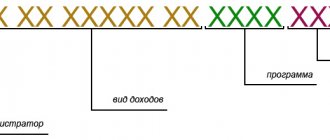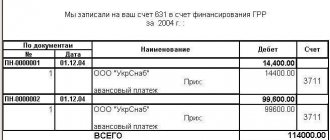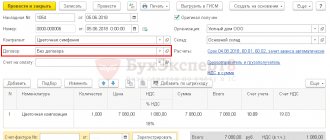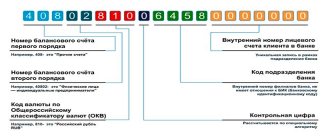- The “Invoice” service provides for customizable auto-numbering of Agreements, Invoices, TORG-12 Waybills, Invoices and Acts.
- According to the legislation of the Russian Federation, strict numbering is not provided for bills, acts, delivery notes and invoices (including advance ones). This means that the choice of the type of numbering for these documents remains with the organization.
- You can encode in the account number, for example, the day, month, year, department number, document serial number for the day, for the year, or other information necessary for accounting in your organization.
- In order to remove all possible questions from tax authorities, the principle of document numbering must be reflected in the organization’s accounting policies.
Automatic document numbering
By default, the system uses a continuous numbering order:
- Agreement - %ny%
, serial number for the year (min. length 6 digits, can be changed in the database settings), examples: 000001, 002340, 1000001; - Account - %ny%
, serial number for the year (min. length 6 digits, can be changed in the database settings), examples: 000001, 002340, 1000001; - Waybill - %ey%
, a single serial number for Waybills and Certificates for the year (min. length 6 digits), examples: 000001, 002340, 1000001; - Act - %ey%
, a single serial number for Invoices and Acts for the year (min. length 6 digits), examples: 000001, 002340, 1000001; - Invoice - %ey%
, a single serial number for Advance and regular Invoices for the year (min. length 6 digits), examples: 000001, 002340, 1000001; - Advance Invoice - A%ey%
, a single serial number for Advance and regular Invoices for the year (min. length 6 digits), examples: A000001, A002340, A1000001; - Payment order - %nyi%
(min. length 1 digit), serial number for the year, examples: 1, 2340, 1000001.
Invoice received
When receiving an invoice from a supplier, they are entered into 1C with the details that the supplier indicated in the primary documents. Due to this, invoices are reflected equally for the supplier and the buyer.
Our team provides consulting, configuration and implementation services for 1C. You can contact us by phone +7 499 350 29 00 . Services and prices can be seen at the link. We will be happy to help you!
For example, we created a document, indicated the number and date:
Let’s print the invoice using the “Print” button:
Numbering format
set default numbering format
| Parameter | Description |
| %d% | number (example: 08) |
| %m% | month (example: 02) |
| %Y% | year (example: 2010) |
| %y% | year (example: 10) |
| %z% | day of year (example: 97, from 1 to 365) |
| %Z% | day of year (example: 097, from 001 to 365) |
| %nd% | serial number of the document for the day (with a minimum number of digits) |
| %ny% | serial number of the document for the year - continuous numbering (with a minimum number of digits) |
| %ndi% | serial number of the document for the day (without minimum number of digits) |
| %nyi% | serial number of the document for the year - continuous numbering (without a minimum number of digits) |
| Additional parameter for uniform numbering of Acts and Invoices | |
| %ed% | a single serial number for Acts and Invoices. per day (with a minimum number of digits) |
| %ey% | a single serial number for Acts and Invoices. per year - continuous numbering (with a minimum number of digits) |
| %edi% | a single serial number for Acts and Invoices. per day (without minimum number of digits) |
| %eyi% | a single serial number for Acts and Invoices. per year - continuous numbering (without minimum number of digits) |
| Additional numbering option for regular and advance Invoices | |
| %ed% | a single serial number for regular and advance invoices per day (with a minimum number of digits) |
| %ey% | a single serial number for regular and advance invoices for the year - continuous numbering (with a minimum number of digits) |
| %edi% | a single serial number for regular and advance invoices per day (without a minimum number of digits) |
| %eyi% | a single serial number for regular and advance invoices for the year - continuous numbering (without a minimum number of digits) |
What are the rules for numbering invoices?
The main (and only) rule is that numbers are assigned in chronological order as invoices are compiled/issued (subparagraph “a” of paragraph 1 of the rules for filling out an invoice, subparagraph “a” of paragraph 1 of the rules for filling out an adjustment invoice) .
An organization can set the numbering renewal period independently in its accounting policies, depending on the number of documents it prepares. For example, you can resume numbering from the beginning of the next year, quarter, month. The only thing that officials spoke out against was the daily numbering of invoices from the first number (letter of the Ministry of Finance of Russia dated October 11, 2013 No. 03-07-09/42466).
Invoice numbers may not only consist of numbers: the use of letter prefixes and digital indices is allowed. The latter must be included in invoices:
- separate divisions (the document number separated by a slash is supplemented by the digital index of the OP, fixed in the accounting policy);
- participants of partnerships or trustees (the company’s transaction index for a specific agreement is also indicated through a slash).
Read more about invoice details and their significance for this document in this article .
Numbering in branches and separate divisions
As in the case of an organization without divisions, there is no strict regulation here. PKO and RKO are numbered, guided by considerations of convenience and completeness of reflection of cash accounting data. Typically, each separate division is assigned a prefix: letters or numbers, its encoding. The cash order number will contain a prefix, it is entered through a horizontal line or a fraction line.
This numbering is needed, for example, if separate divisions independently record revenue and then send the data to the head office. If at the same time there is a need to keep records by type of income, this information can be encoded in the PKO number.
The cash order number can thus consist of three parts, separated by a hyphen or fraction:
- division (branch) coding;
- income coding;
- PKO number,
If the division by type of income is not relevant for an organization in accounting, it can be excluded.
Note that with all the obvious difficulties of continuous numbering of cash orders, when an organization has branches or separate divisions, it is advisable to be guided by this principle. Identification of branches (divisions) should be based on the use of additional information in the structure of the PKO and RKO numbers (as shown above), and not on parallel numbering of cash documents.
The numbering order of PKOs and RKOs must be reflected in the local regulations of the business entity. Divisions and branches should be given special attention in LA, taking into account their territorial distance from the head office.
Main
- The order of numbering of incoming and outgoing cash orders is established by the organization independently and is fixed in local regulations.
- Numbering usually starts from the beginning of the year, less often - a quarter, but continuous numbering for other periods is also allowed.
- The numbering of PKO and RKO must be organized so that information about incoming and outgoing cash transactions is reflected reliably and completely.
- The principles of continuous numbering and adherence to chronology are basic.
- The numbers of incoming and outgoing orders at the cash desk in branches and divisions are assigned using additional entries in the document number: through a fraction or a hyphen.
How should PKO and RKO be numbered?
Many organizations begin to number PKO and RKO again from the beginning of the year. However, not a single legislative or explanatory document of the regulatory authorities contains such a rule. It is dictated only by the convenience of recording data from primary cash documents. Strictly speaking, it is not necessary to start in January with one; you can continue the continuous numbering of cash orders from last year.
LLC "Lentochka" in the period from 02/12/2014 to 06/25/2014, on the basis of requests from Alliance Trade Group LLC, supplied goods to Alliance Trade Group LLC, the transfer of which was documented by waybills signed by representatives of the seller and buyer. Referring to the availability of LLC Trading Group Alliance of 1,570,755 rubles. 50 kopecks debts for the delivered goods, Lentochka LLC filed this claim with the arbitration court. Do cash receipt orders together with cash receipts confirm the fact of payment for goods? View the court decision
Large organizations with a large cash flow of documents often establish in their accounting policies the quarterly numbering of PKO and RKO, i.e. Every quarter they begin to number documents anew.
With any numbering method chosen, two rules must be observed:
- numbering must be continuous;
- numbering must be chronological.
Does the receipt for the cash receipt order the expenditure of accountable amounts?
This means that incoming and outgoing orders must be numbered in the order in which they were issued, taking into account the calendar dates of cash transactions.
On a note! The number, unlike the date, in itself is not a mandatory requisite of the accounting document (see Federal Law No. 402 “On Accounting” dated 6-12-11, Article 9 Part 2).
Article 15 of the Code of Administrative Offenses of the Russian Federation is devoted to violations of the procedure for conducting cash transactions. It does not directly stipulate responsibility for violating the numbering of cash receipts and expenditure orders, but only for violating the procedure for working with cash at the cash desk. At the same time, if the numbering order is not observed, for regulatory authorities this may become a signal indicating serious violations of the law.
Question: The buyer made an advance payment for the goods in cash. A few days later it turned out that the goods would not be delivered, and therefore it was necessary to return the advance payment. Should an organization issue a cash receipt when returning an advance and issue a cash register receipt? View answer
Rules for maintaining document numbering in 1C 8.3
Send this article to my email
Very often, users working in the 1C program, regardless of the configuration used, have questions related to the numbering of documents: on what principle is the number created, how to change the designations in the numbering, how to change an already created document number, etc. In this article I will talk about the rules for maintaining document numbering in 1C and thereby answer the main questions related to this topic.
The numbering of documents in 1C 8.3 is based on a single principle. The document number consists of 11 characters. Let's look at the example of the number YUPBA-000603.
I will set up your 1C. Experience since 2004. Read more →
• UP is the prefix of the organization. The organization prefix is set in the organization card in the form of alphabetic characters and is automatically inserted into the number. This designation is used when maintaining two or more organizations within one database, in order to separate the document numbers of these organizations. If only one organization is kept in the database, then it is not necessary to fill in the prefix; 00 will be substituted for the letter designation in the document.
• BA - the prefix of this information base - is indicated in the database when setting up synchronization with other databases and is intended to determine the program in which the documents were entered and avoid duplication of data. If exchange with other databases is not carried out, then the prefixes can be left blank; in this case, the program will substitute the value 00.
• The '-' sign is not changed, it is used to separate the number. When outputting printed forms from program documents, the left part of the number (before “-”) will not be output.
• 000603 - the remaining 6 characters on the right side of the number are filled in ascending order, starting from 000001.
Filling in the document number occurs when recording the created document and does not change during subsequent work with this document.
In order to make a correction to an already filled in value in the “Number” field, you need to start editing the value and then the program will display the message “The number is filled in automatically when recording. Will you continue editing? Click “Yes” and make corrections.
In this case, a check is made for duplicate numbers, and entering a number that is already used in the program will not work. When assigning numbers, the program focuses on the number with the highest ordinal value and creates the next one. Those. If in the program you corrected document 0000-000500 to 0000-000600, then the next document will be recorded with the number 0000-000601. And even if you make a mistake in the number of characters (for example, 0000-060), the system will enter the next numbers with the same number of characters (0000-061).
For 1C users working in the Enterprise Accounting 3.0 configuration, there is a nice bonus in the form of the Express Accounting Check service, which checks the numbers of incoming and outgoing cash orders and invoices for compliance with the recommended numbering order. The procedure itself is described as a subject of verification control, and if it is violated, the service will report an error, indicate possible causes and help automatically make corrections. This service is located in the “Reports” → “Express check” section.
Further
Watch video instructions on channel 1C PROGRAMMER EXPERT
EVERYONE MUST DO THEIR JOB! TRUST THE 1C SETUP TO A PROFESSIONAL. MORE →
Discuss the article on the 1C forum?
Application
Continuous numbering is a solution that is used to protect content and protect securities from falsification. In addition, this approach makes working with documentation easier. In books you can easily find the necessary information by looking at the page numbers in the table of contents. Continuous page numbering is a sequential change of numbers in increasing order in documents or publications. For example, during preparation for a tender, the necessary papers are collected. They are numbered consecutively, as if we are not talking about a stack of different documents, but about a single copy.








